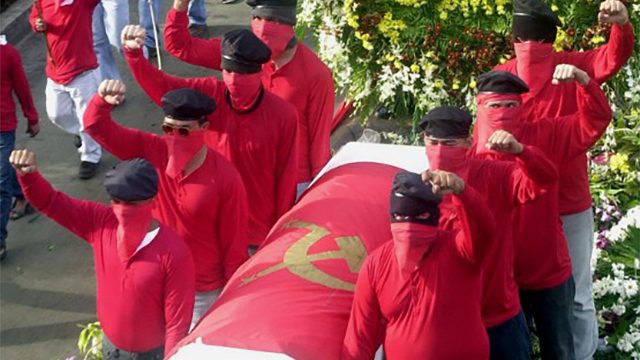SUMMARY
This is AI generated summarization, which may have errors. For context, always refer to the full article.
A friend sent a YouTube link to the American pop singer Don McLean’s now iconic song American Pie, and reminded me that the line “and they were singing dirges in the dark the day the music died,” could very well refer to what has happened to the communists of the 1970s and 1980s. This prompted quick check at the bookshelf to pick out a number of memoirs that Filipino communists from the so-called “First Quarter Storm” generation and their successor, the “martial law babies” have written in the last decade.
One of the enduring myths of these memoirs is that even today, when they have all started to drift towards middle age, these cadres and their national democratic understudies have remained brothers and sisters. A couple of writings did acknowledge that this unity had frayed since 1986, and their authors have timidly mentioned the splits of the late 1980s and the early 1990s.
But this is unfortunate for if one wants some historical context as to why many of these “veterans” of the Storm and the dark years of the dictatorship are now pitted against each in the battle between President Rodrigo Duterte and his opponents, one needs to go as far back as the splits of the 1980s, especially after the CPP leadership under Jose Ma. Sison, resolved the ideological debates through a sanctioned killing of those the CPP’s eternal chairman tagged openly as spies and renegades
The stories of these assassinations still have to be written.
We still await the brave ex-cadre who will write about the tragic fortunes of Filemon “Popoy” Lagman, twice the leader of the CPP’s Manila-Rizal regional committee, disciplined and sent to the countryside after 1975, when he and the rest of the committee defied the edict from the Politburo to break up the Party’s electoral alliance with the anti-Marcos traditional politicians and the hated social democrats formed to challenge the dictatorship’s Kilusang Bagong Lipunan Manila slate led by Imelda Marcos and composed of 20 other forgettable characters (the one I only remember was Foreign Secretary Carlos Romulo whose campaign speeches sounded like academic lectures, boring a lot of hakot listeners to sleep).
Lagman did his time in the countryside, sacrificed a lot (his wife was believed killed in a military encounter), and regained his post in the last years of the dictatorship. After Marcos was ousted, however, the Manila-Rizal regional organization broke away from the Party after the 5-man Politburo’s disastrous decision to boycott the 1986 elections (Yes Virginia, only 5 people decided the nearly 1-million communist movement’s fate at a time when the politics of the period was clearly leaning towards the Left. Talk about radical democracy!). It was cadres of the regional organization that formed the initial core group of what is now the party-list group Sanlakas and its labor federation the Bukluran ng Manggagawang Pilipino. In its early years, and under the leadership of Lagman, it was one of the strongest and fiery non-CPP left groups.

Lagman was assassinated on February 6, 2001 at the Diliman campus of the University of the Philippines. According to Ben Reid his was “the first political assassination to occur under the new regime of Gloria Macapagal Arroyo and signals the possible beginning of a campaign of terror targeting the country’s leftist movement.” Reid writes that an unnamed “rightist faction of the military loyal to the ousted president Joseph Estrada was behind the killing,” its aim being to destabilize the still wobbly regime of Gloria Arroyo. This was the official line that Lagman’s Sanlakas would adopt.
Others however suspect that Lagman’s assassination was the first of several rubouts of the top ex-cadres of the Party who disagreed with the Filipino Ayatollah’s return to Maoist fundamentals. Lagman was known as the CPP’s Lenin, because he advocated for a communist movement with a strong influential “proletarian” (i.e., industrial worker base), shared Karl Marx’s disdainful description of the peasantry as a “sack of potatoes” (pace the insistence of Mao and his Filipino acolyte Sison that peasants were the mass base of the revolution), and saw very little value in a long-drawn protracted guerilla warfare against the Philippine government. For Lagman, communists could only come to power though urban uprisings and massive general strikes, and where the New People’s Army was to just play a supportive role.
This urban-centered strategy demanded the broadest unity of the diverse groups and classes that live in the metropolis, to give the revolution the heft to challenge and destroy police and military power, and ultimately the government. To achieve this “united front” the Party needed to make compromises to its anti-Marcos ideological rivals. Hence the Manila-Rizal took seriously the electoral collaboration it made with Benigno Aquino and the elite opposition in 1975 to the chagrin of their Party bosses.
This argument was also used as justification for Lagman questioning the validity and relevance of Mao Tse Tung Thought as the CPP’s ideological foundation after the big 1986 brouhaha. For which he was allegedly extra-judicially killed.
That death and Sison’s indirect threats before that, plus the expulsion or forced resignation of other anti-Sison cadres and the break away by regional organizations like the Manila-Rizal presaged an unceasing contention among these radicals. Its current and perhaps most poisonous edition is the fight between pro- and anti-Duterte radicals and ex-radicals. – Rappler.com
(To be continued)
Add a comment
How does this make you feel?
There are no comments yet. Add your comment to start the conversation.